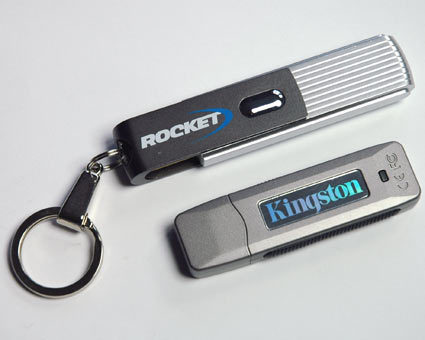Two Fast and Functional USB Flash Drives
Power Meets Intelligence: Who Wins?
The competition for the fastest USB flash drive is now reaching epic proportions: nearly every week, the current record holder falls to a new contender. In reaction to our recent tests in May 2005, numerous additional vendors contacted us to demand an immediate follow-up. Because this market is full of similar products, we picked two real standouts from Kingston and Memina (Hana Micron, Samsung Group) for this story.
Just a few months ago, Memina's so-called Pocket Rocket USB flash drive left the competition in the dust with data transfer rates of about 20 megaBytes per second. But the unfortunate product name too often led to laughter - suppressed, or even out loud - as "pocket rocket" is also an off-color term in English. Selling a product with a name carrying unintended sexual innuendo won't do, of course, so the product name promptly lost its "Pocket" and was shortened simply to "Rocket." The designation remains apt, as the Rocket remains the fastest flash drive around.
At Kingston, the company is chasing the speed crown with its DataTraveler Elite line, but apparently also sees a strong market for intelligent USB flash drives - this refers to bundled software that extends the uses for its products, thereby growing market reach. That's where the Migo Edition of the DataTraveler II Plus appears aimed, based on its ability to let you carry your desktop wherever you might need it. Because this includes most important files and data, such as e-mail folders, browser favorites and history files, this drive basically lets you snapshot your work environment, then use it on other computers with ease. Kingston, of course, wants to make sure that its flash drive's speed is at least adequate for this job.
This led us to ask ourselves a bigger question: Does it make more sense to invest in a bigger, faster flash drive or to put that money into added functionality? To answer this query properly, we extended our test suite to include an interesting additional check: how does performance measure up when a flash drive must handle simultaneous reads and writes?
Get Tom's Hardware's best news and in-depth reviews, straight to your inbox.
Current page: Power Meets Intelligence: Who Wins?
Next Page Protection Scheme: 1.0 For Memina
Patrick Schmid was the editor-in-chief for Tom's Hardware from 2005 to 2006. He wrote numerous articles on a wide range of hardware topics, including storage, CPUs, and system builds.
